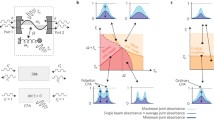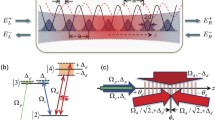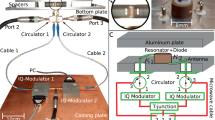Abstract
The ability to drive a system with an external input is a fundamental aspect of light–matter interaction. The coherent perfect absorption (CPA) phenomenon extends to the general multibeam interference phenomenology the well-known critical coupling concepts (Haus in Waves and fields in optoelectronics. Prentice-Hall, Englewood Cliffs, 1984; Yariv and Yeh in Optical Electronics in Modern Communication. Oxford University Press, New York, 2007). The latter detail the conditions under which the energy of the input field is fed in full to the absorbing element. In a multi-port system, the relative phase of the incoming fields can yield the ultimate control of the absorption, from CPA to complete transparency (coherent perfect transparency, CPT), and also beyond, in amplifying regimes, to laser threshold control (Longhi in Phys Rev A 82:031801, 2010; Sun et al. in Phys Rev Lett 112:143903, 2014). This interferometric control of absorption can be employed to reach perfect energy feeding into nanoscale systems such as plasmonic nanoparticles (Noh et al. in Phys Rev Lett 108(18):186805, 2012), and multi-port interference can be used to enhance the absorption when they are embedded in a strongly scattering system (Chong and Stone in Phys Rev Lett 107(16):163901, 2011), with potential applications to nanoscale sensing. Here we review the two-port CPA in reference to photonic structures which can resonantly couple to the external fields. A revised two-port theory of CPA is illustrated, which relies on the Scattering Matrix formalism and is valid for all linear two-port systems with reciprocity. Through a semiclassical approach, treating two-port critical coupling conditions in a non-perturbative regime, it is demonstrated that the strong-coupling regime and the critical coupling condition can indeed coexist; in this situation, termed strong critical coupling (Zanotto et al. in Nature Phys 10(11):830–834, 2014), all the incoming energy is converted into polaritons. Experimental results are presented, which clearly display the elliptical trace of absorption as function of input unbalance in a thin metallo-dielectric metamaterial, and verify polaritonic CPA in an intersubband polariton photonic crystal membrane resonator. Concluding remarks discuss the future perspectives of CPA with photonic structures.







Similar content being viewed by others
Notes
It should be noticed that a degenerate situation, in which \(S\) is the zero matrix, can also occur: this case corresponds to two decoupled single-port perfect absorbers.
References
Amo A, Sanvitto D, Laussy F, Ballarini D, Del Valle E, Martin M, Lemaitre A, Bloch J, Krizhanovskii D, Skolnick M et al (2009) Collective fluid dynamics of a polariton condensate in a semiconductor microcavity. Nature 457(7227):291–295
Andreani LC, Panzarini G, Gérard J-M (1999) Strong-coupling regime for quantum boxes in pillar microcavities: theory. Phys Rev B 60:13276–13279. doi:10.1103/PhysRevB.60.13276
Aspnes D, Studna A (1983) Dielectric functions and optical parameters of si, ge, gap, gaas, gasb, inp, inas, and insb from 1.5 to 6.0 ev. Phys Rev B 27(2):985
Auffèves A, Gerace D, Gérard J-M, Santos MF, Andreani L, Poizat J-P (2010) Controlling the dynamics of a coupled atom-cavity system by pure dephasing. Phys Rev B 81(24):245419
Auffèves-Garnier A, Simon C, Gérard J-M, Poizat J-P (2007) Giant optical nonlinearity induced by a single two-level system interacting with a cavity in the purcell regime. Phys Rev A 75:053823. doi:10.1103/PhysRevA.75.053823
Barnett SM, Jeffers J, Gatti A, Loudon R (1998) Quantum optics of lossy beam splitters. Phys Rev A 57:2134–2145. doi:10.1103/PhysRevA.57.2134
Chew WC (1995) Waves and fields in inhomogeneous media, vol 522. IEEE press, NewYork
Chong YD, Ge L, Cao H, Stone AD (2010) Coherent perfect absorbers: time-reversed lasers. Phys Rev Lett 105:053901. doi:10.1103/PhysRevLett.105.053901
Chong Y, Stone AD (2011) Hidden black: coherent enhancement of absorption in strongly scattering media. Phys Rev Lett 107(16):163901
Chutinan A, John S (2008) Light trapping and absorption optimization in certain thin-film photonic crystal architectures. Phys Rev A 78:023825. doi:10.1103/PhysRevA.78.023825
De Liberato S, Ciuti C (2009) Stimulated scattering and lasing of intersubband cavity polaritons. Phys Rev Lett 102:136403. doi:10.1103/PhysRevLett.102.136403
De Liberato S, Ciuti C, Phillips CC (2013) Terahertz lasing from intersubband polariton-polariton scattering in asymmetric quantum wells. Phys Rev B 87:241304. doi:10.1103/PhysRevB.87.241304
DeglInnocenti R, Zanotto S, Tredicucci A, Biasiol G, Sorba L (2011) One-dimensional surface-plasmon gratings for the excitation of intersubband polaritons in suspended membranes. Solid State Commun 151(23):1725–1727. doi:10.1016/j.ssc.2011.09.002
Dietze D, Unterrainer K, Darmo J (2013) Role of geometry for strong coupling in active terahertz metamaterials. Phys Rev B 87(7):075324
Dini D, Köhler R, Tredicucci A, Biasiol G, Sorba L (2003) Microcavity polariton splitting of intersubband transitions. Phys Rev Lett 90:116401. doi:10.1103/PhysRevLett.90.116401
Fan S, Suh W, Joannopoulos JD (2003) Temporal coupled-mode theory for the fano resonance in optical resonators. J Opt Soc Am A 20(3):569–572. doi:10.1364/JOSAA.20.000569
Ghebrebrhan M, Bermel P, Yeng Y, Celanovic I, Joannopoulos J, Soljači č M (2011) Tailoring thermal emission via \(q\) matching of photonic crystal resonances. Phys Rev A 83:033810. doi:10.1103/PhysRevA.83.033810
Granet G, Guizal B (1996) Efficient implementation of the coupled-wave method for metallic lamellar gratings in tm polarization. J Opt Soc Am A 13(5):1019–1023. doi:10.1364/JOSAA.13.001019
Haus HA (1984) Waves and fields in optoelectronics. Prentice-Hall, Englewood Cliffs
Jalas D, Petrov A, Eich M, Freude W, Fan S, Yu Z, Baets R, Popovic M, Melloni A, Joannopoulos JD, Vanwolleghem M, Doerr CR, Renner H (2013) What is—and what is not—an optical isolator. Nature Photon 7(8):579–582. doi:10.1038/nphoton.2013.185
Johnson PB, Christy R-W (1972) Optical constants of the noble metals. Phys Rev B 6(12):4370
Kaluzny Y, Goy P, Gross M, Raimond JM, Haroche S (1983) Observation of self-induced rabi oscillations in two-level atoms excited inside a resonant cavity: the ringing regime of superradiance. Phys Rev Lett 51:1175–1178. doi:10.1103/PhysRevLett.51.1175
Kimble HJ (1994) Structure and dynamics in cavity quantum electrodynamics, in cavity quantum electrodynamics. In: Berman BR Academic Press, Boston
Longhi S (2010) Pt-symmetric laser absorber. Phys Rev A 82:031801. doi:10.1103/PhysRevA.82.031801
Manceau J-M, Zanotto S, Sagnes I, Beaudoin G, Colombelli R (2013) Optical critical coupling into highly confining metal-insulator-metal resonators. Appl Phys Lett 103(9):091110
Noh H, Chong Y, Stone AD, Cao H (2012) Perfect coupling of light to surface plasmons by coherent absorption. Phys Rev Lett 108(18):186805
Peter E, Senellart P, Martrou D, Lemaitre A, Hours J, Gerard J, Bloch J (2005) Exciton-photon strong-coupling regime for a single quantum dot embedded in a microcavity. Phys Rev Lett 95:067401. doi:10.1103/PhysRevLett.95.067401
Reithmaier JP, Sek G, Loffler A, Hofmann C, Kuhn S, Reitzenstein S, Keldysh LV, Kulakovskii VD, Reinecke TL, Forchel A (2004) Strong coupling in a single quantum dot-semiconductor microcavity system. Nature 432:197. doi:10.1038/nature02969
Savona V, Andreani LC, Schwendimann P, Quattropani A (1995) Quantum well excitons in semiconductor microcavities: unified treatment of weak and strong coupling regimes. Solid State Commun 93(9):733–739. doi:10.1016/0038-1098(94)00865-5
Shen J-T, Fan S (2009a) Theory of single-photon transport in a single-mode waveguide. i. coupling to a cavity containing a two-level atom. Phys Rev A 79:023837. doi:10.1103/PhysRevA.79.023837
Shen J-T, Fan S (2009b) Theory of single-photon transport in a single-mode waveguide. ii. coupling to a whispering-gallery resonator containing a two-level atom. Phys Rev A 79:023838. doi:10.1103/PhysRevA.79.023838
Shen J-T, Fan S (2010) Quantum critical coupling conditions for zero single-photon transmission through a coupled atom-resonator-waveguide system. Phys Rev A 82:021802. doi:10.1103/PhysRevA.82.021802
Srinivasan K, Painter O (2007) Mode coupling and cavity-quantum-dot interactions in a fiber-coupled microdisk cavity. Phys Rev A 75:023814. doi:10.1103/PhysRevA.75.023814
Sun Y, Tan W, Li H-Q, Li J, Chen H (2014) Experimental demonstration of a coherent perfect absorber with pt phase transition. Phys Rev Lett 112:143903. doi:10.1103/PhysRevLett.112.143903
Thompson RJ, Rempe G, Kimble HJ (1992) Observation of normal-mode splitting for an atom in an optical cavity. Phys Rev Lett 68:1132–1135. doi:10.1103/PhysRevLett.68.1132
Wan W, Chong Y, Ge L, Noh H, Stone AD, Cao H (2011) Time-reversed lasing and interferometric control of absorption. Science 331(6019):889–892. doi:10.1126/science.1200735
Weisbuch C, Nishioka M, Ishikawa A, Arakawa Y (1992) Observation of the coupled exciton-photon mode splitting in a semiconductor quantum microcavity. Phys Rev Lett 69:3314–3317. doi:10.1103/PhysRevLett.69.3314
Yariv A, Yeh P (2007) Photonics: optical electronics in modern communication. Oxford University Press, New York
Yoshie T, Scherer A, Hendrickson J, Khitrova G, Gibbs HM, Rupper G, Ell C, Shchekin OB, Deppe DG (2004) Vacuum rabi splitting with a single quantum dot in a photonic crystal nanocavity. Nature 432:200. doi:10.1038/nature03119
Yu Z, Raman A, Fan S (2012) Thermodynamic upper bound on broadband light coupling with photonic structures. Phys Rev Lett 109:173901. doi:10.1103/PhysRevLett.109.173901
Zanotto S, Degl’Innocenti R, Sorba L, Tredicucci A, Biasiol G (2012) Analysis of line shapes and strong coupling with intersubband transitions in one-dimensional metallodielectric photonic crystal slabs. Phys Rev B 85:035307. doi:10.1103/PhysRevB.85.035307
Zanotto S, Mezzapesa FP, Bianco F, Biasiol G, Baldacci L, Vitiello MS, Sorba L, Colombelli R, Tredicucci A (2014) Perfect energy-feeding into strongly coupled systems and interferometric control of polariton absorption. Nature Phys 10(11):830–834. doi:10.1038/NPHYS3106
Acknowledgments
This work was supported in part by the ERC advanced Grant No. 321122 SouLMan.
Author information
Authors and Affiliations
Corresponding author
Rights and permissions
About this article
Cite this article
Baldacci, L., Zanotto, S. & Tredicucci, A. Coherent perfect absorption in photonic structures. Rend. Fis. Acc. Lincei 26 (Suppl 2), 219–230 (2015). https://doi.org/10.1007/s12210-015-0428-z
Received:
Accepted:
Published:
Issue Date:
DOI: https://doi.org/10.1007/s12210-015-0428-z




